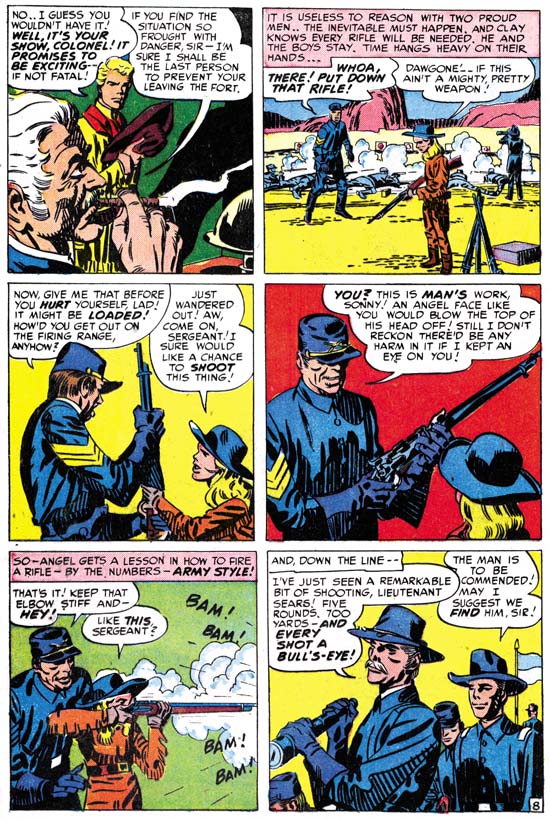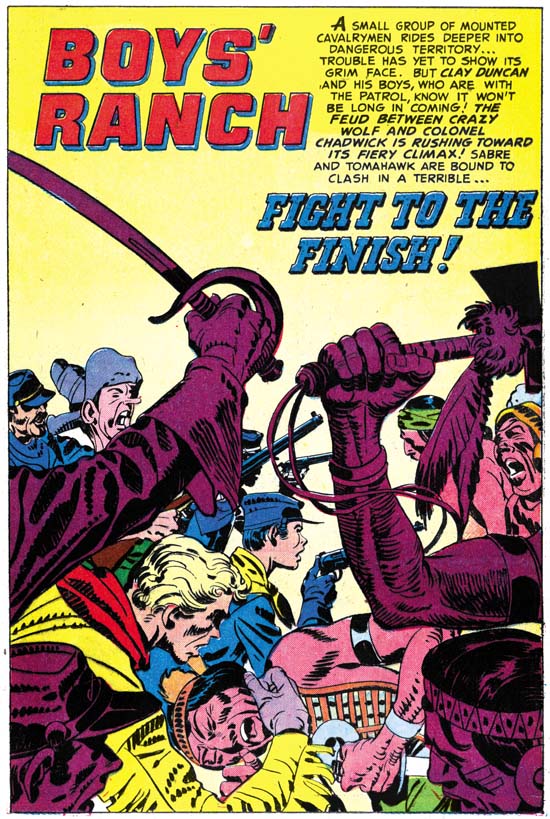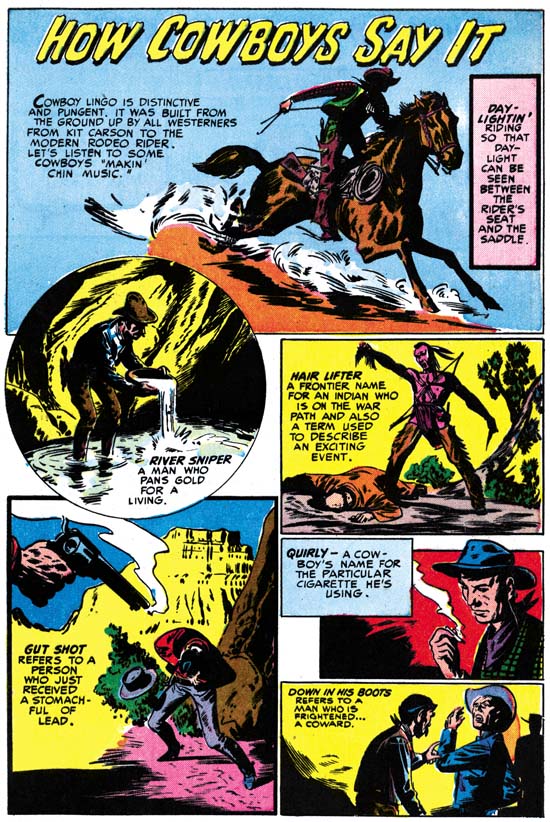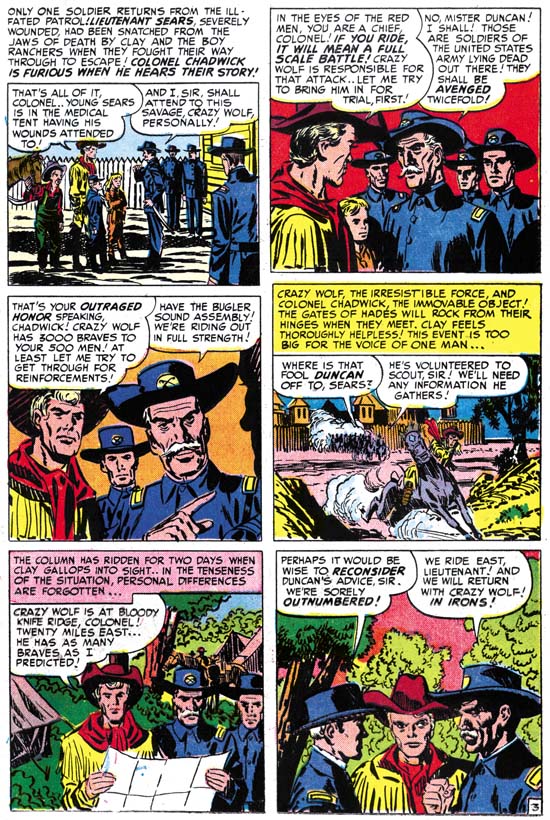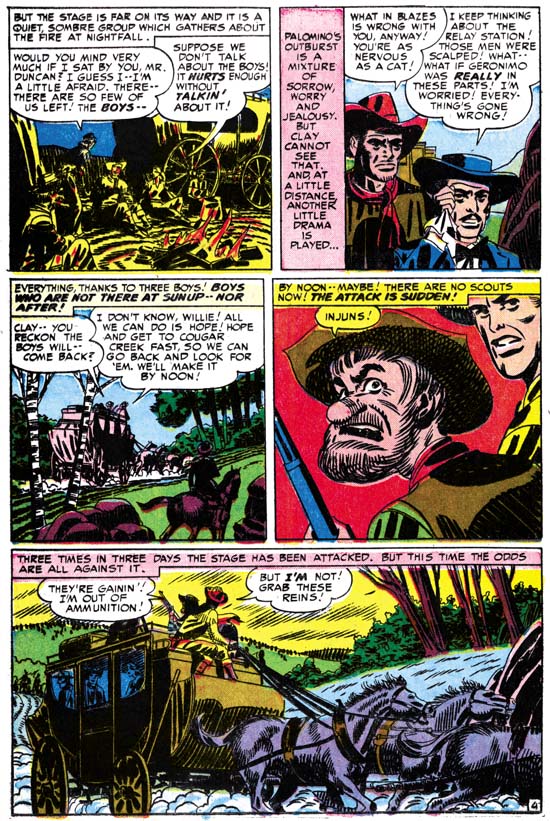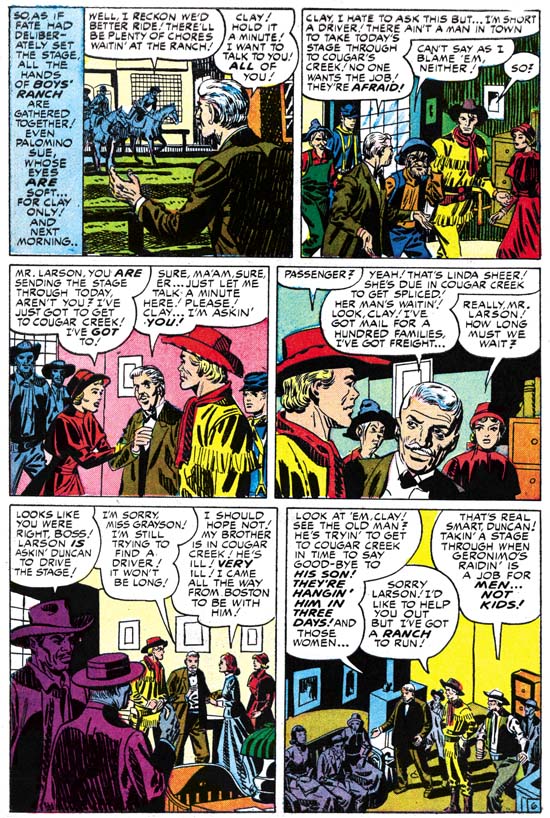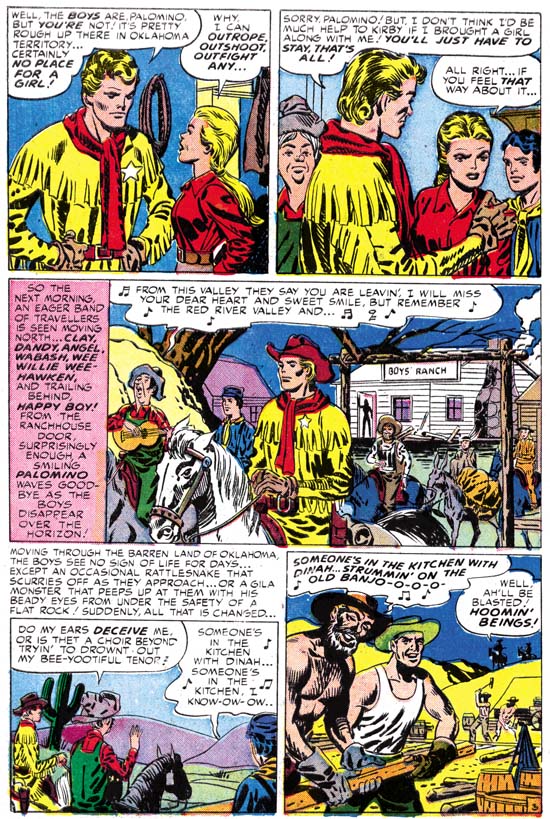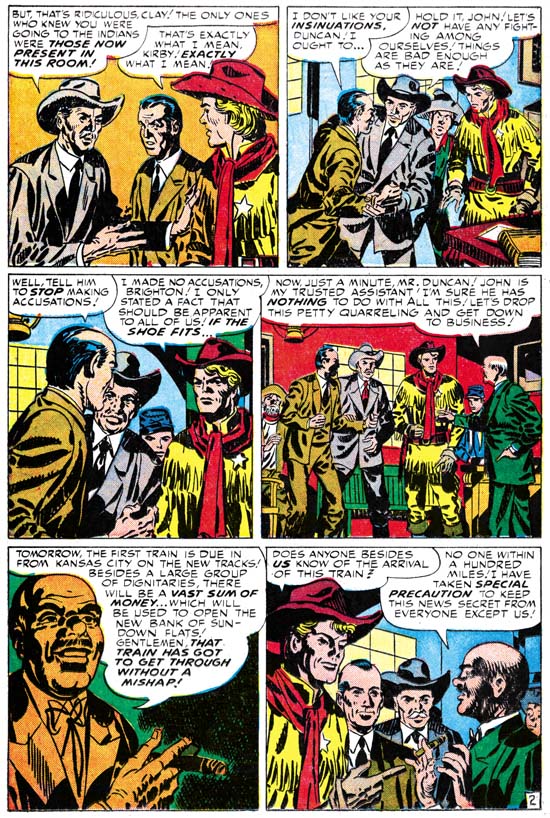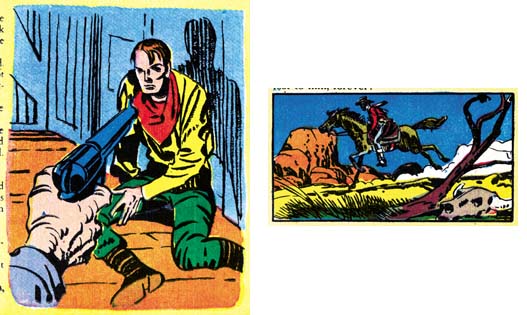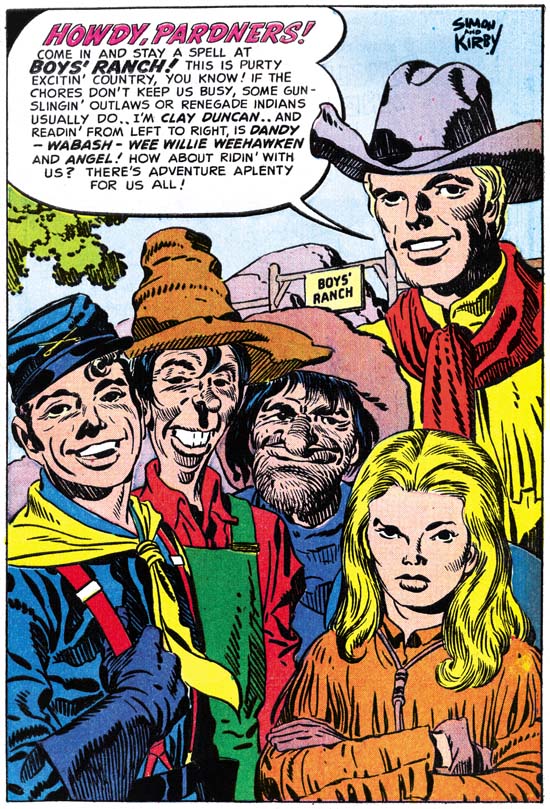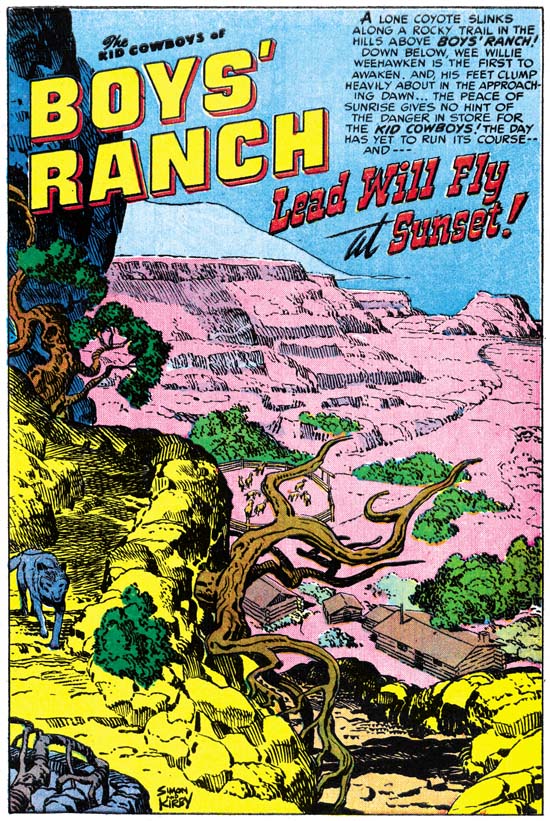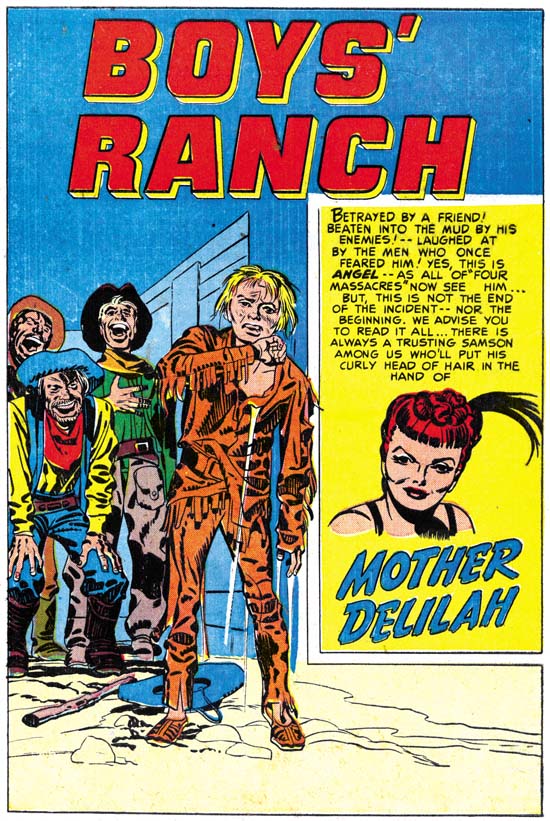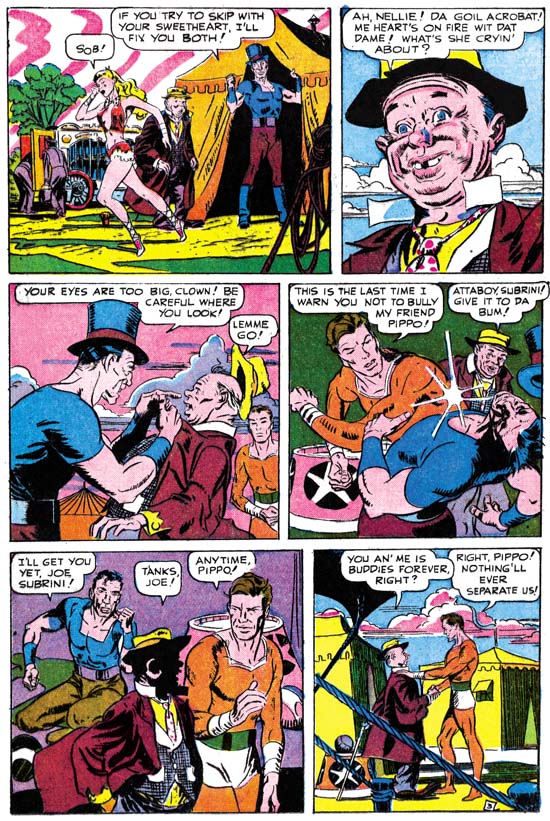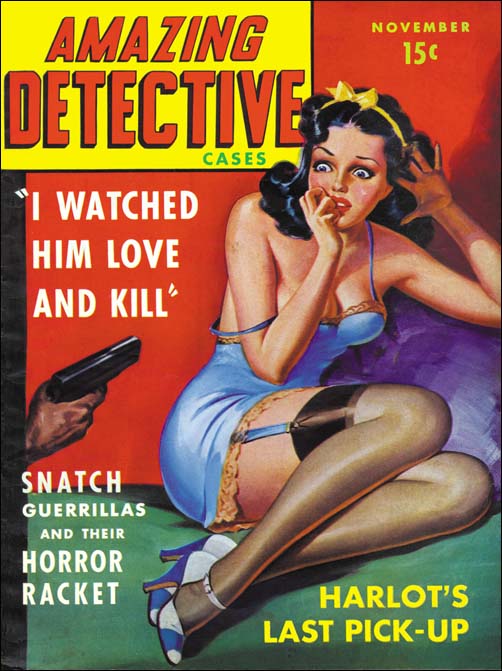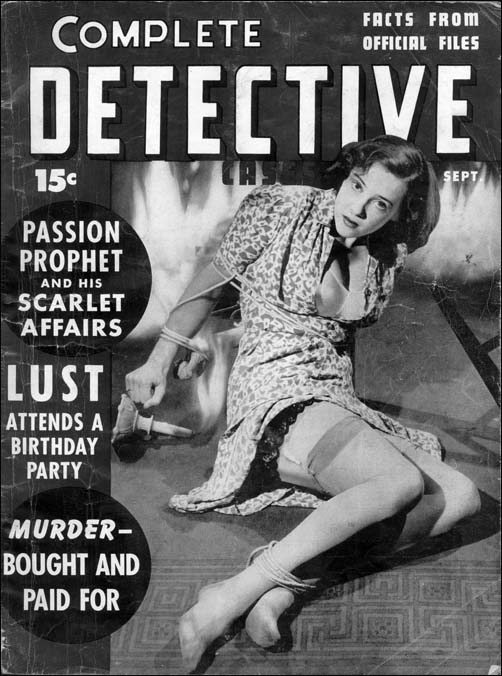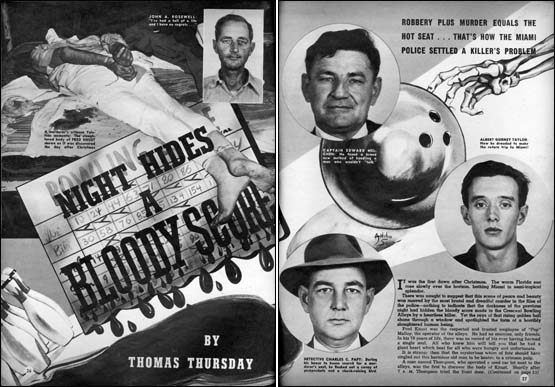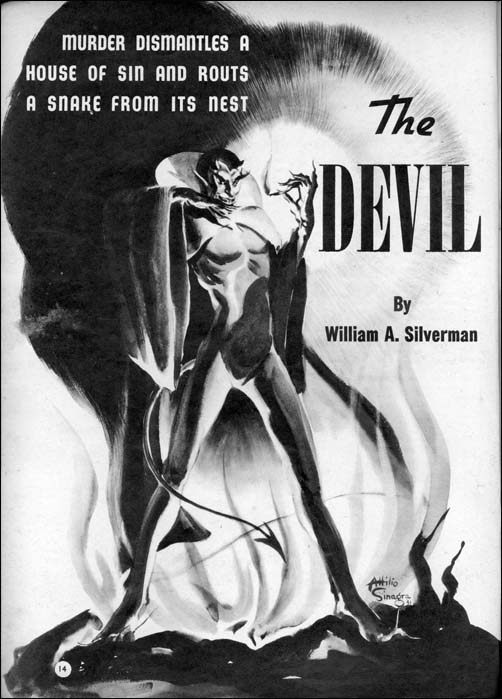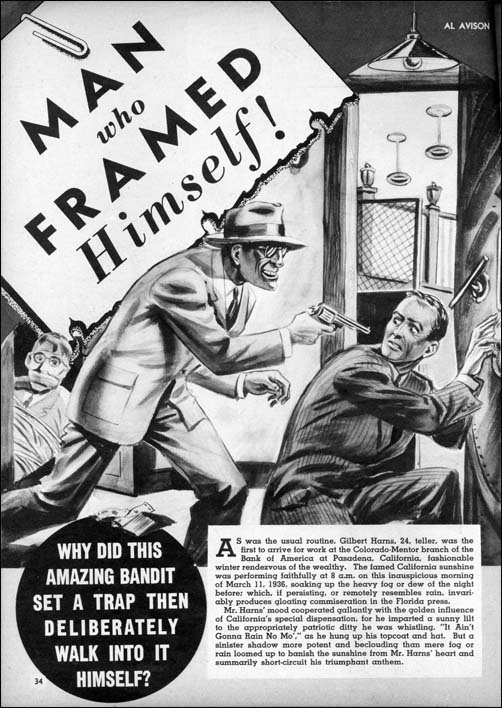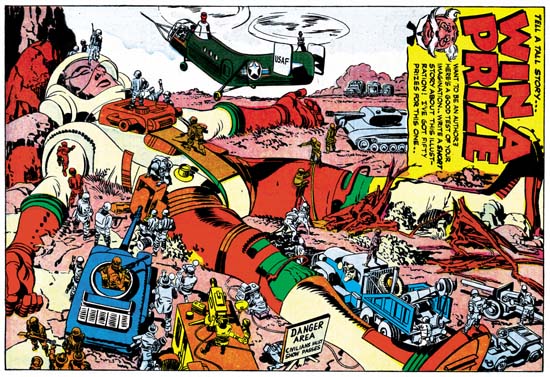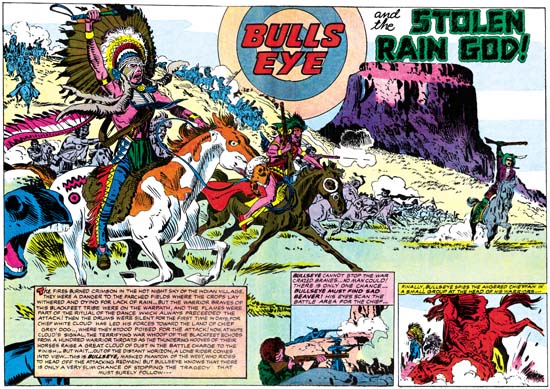
Star Spangled #9 (June 1942), art by Jack Kirby
Simon and Kirby’s initial work for DC was to revitalize an existing feature called Sandman. In the following month they would debut their own creation, The Newsboy Legion (Star Spangled #7, April 1942). Jim Harper was a rookie cop assigned to patrol Suicide Slum. Further he assumes the roll of the Guardian to fight criminals without having to adhere to the restrictions of the law. Harper is also a guardian of another kind; he is a sort of custodian to four street urchins, the Newsboy Legion. The boy gang was a genre that S&K would use a number of times, although not always with a superhero thrown into the mix. A similar combination appeared in another Simon and Kirby creation the Young Allies, only in that feature the superheroes Toro and Bucky were part of the actual gang. Because the cover date for the first Young Allies was Summer, the Newsboy Legion may have actually been published before Joe and Jack’s earlier creation. The combination of superhero and boy gang worked quite well. Suicide Slum provided the Newsboy Legion with plenty of opportunities to get into trouble leading to their eventual rescue by the Guardian. Thus the boys play the roll of side-kicks without the improbability of a superhero partnering with a young boy in his dangerous fight against crime. Another refreshing difference found in the Newsboy Legion concerned Jim Harper’s secret identity as the Guardian. The Newsboys’ suspicions about the Guardian’s true identity would become a running gag for the feature.
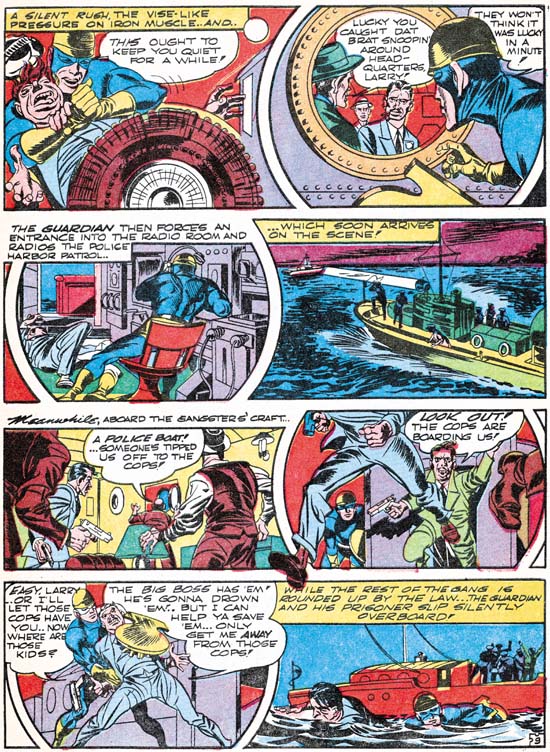
Star Spangled #8 (May 1942) “Last Mile Alley” page 9, art by Jack Kirby
Joe and Jack probably initially did their DC work pretty much by themselves. Any scripts that the DC editors provided must have either been ignored or highly altered. This can be seen by the fact that Simon and Kirby’s work at DC reads pretty much like their work from both before and after. As for art assistants, their former ones were left behind at Timely to take over the art for Captain America Comics and its offshoots. Simon and Kirby would eventually acquire new ones, but initially it was probably just the two of them. This allowed the team to quickly forge a distinctly unique art style. Part of it was derived from their previous work at Timely. In Captain America Kirby had already mastered his handling of action and exaggerated perspective. These continued in Simon and Kirby’s DC work and beyond. Also continued from Captain America was the device of extending figures beyond the panel borders. Circular or semicircular panels would play an important part in DC layouts as they had previously. (I love how the example page I provide above has four semicircular panels yet even more circles were introduced by the spinning wheel and the window in the first two panels.) Retained, at least initially, was a page layout typically of eight panels arranged in four rows. One layout technique that was immediately discarded was the use the more irregular panel borders frequently found in their Timely work.
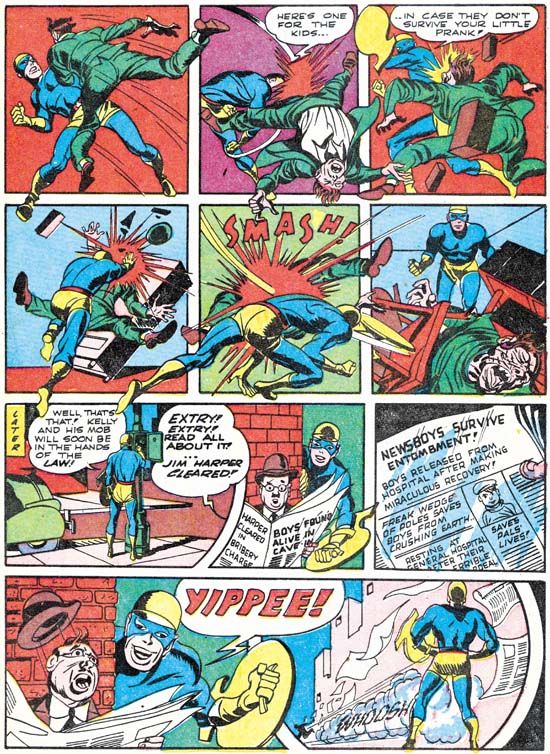
Star Spangled #9 (June 1942) “The Rookie Takes the Rap” page 13, art by Jack Kirby
Kirby was the master of the fight scene and the Newsboy Legion provided plenty of opportunities for Jack to display his talent. I particularly like the sequence found in the end of “The Rookie Takes the Rap” showed above. Jack increases the number of panels per row to three to get in as much fighting as possible. He has also removed all background features that could distract from the Guardian’s confrontation with his opponent. It is not truly a fight because the crook does not stand a chance against the Guardian’s fury. I love the way Kirby has added flying bricks, but as the fight takes place inside a room I have no idea where they came from.

Star Spangled #10 (July 1942) “Kings for a Day” page 11, art by Jack Kirby
Jack Kirby knew how to make things exciting. Take the sequence from “Kings for a Day” shown above. It starts with the Guardian amidst a cityscape. Jack’s unusual use of shadows provides the scene with an eerie quality. As the Guardian ascends, Jack uses perspective to dramatize the action. Views of the background indicate how high the Guardian has climbed. The tower, his final objective, is shown with rapidly narrowing perspective showing he has far more height to obtain. This is followed by tilted views emphasizing the precarious nature of his pursuit. The last panel reveals the object of the Guardian’s heroic efforts while ironically one of the bad guys denigrates the Guardian. This is yet another reminder that Kirby knew how to infuse the story with excitement even in parts where there really was not much going on.
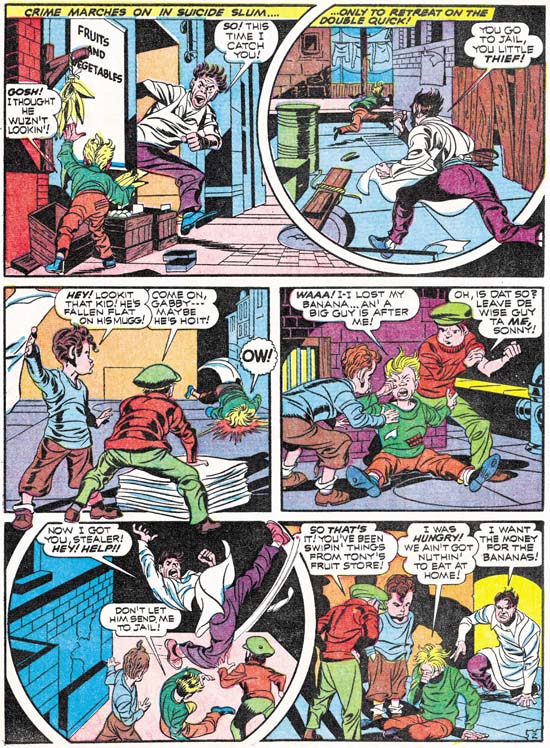
Star Spangled #12 (July 1942) “Prevue of Peril” page 2, art by Jack Kirby
Simon and Kirby switched their typical page from 4 to 3 rows. I had previously observed the same thing in their Sandman stories. In Sandman the transition seemed gradual stretching over several issues. For the Newsboy legion is seems much more abrupt; prior to #12 layouts are predominately four row pages, while subsequent issues are overwhelmingly three row layout,. The larger panels allowed Simon and Kirby to provide greater impact. While I believe that the layout change substantially improved the stories, I question whether that was the true aim. With the war on, both Joe and Jack expected that they would have to enter military service. Knowing this Simon and Kirby began to produce as much work as possible so that DC could use it while they were off serving their country. A larger image provided by the three row panel layout required less fine detailing, therefore less time to draw and ink, and thus aided getting more work done.
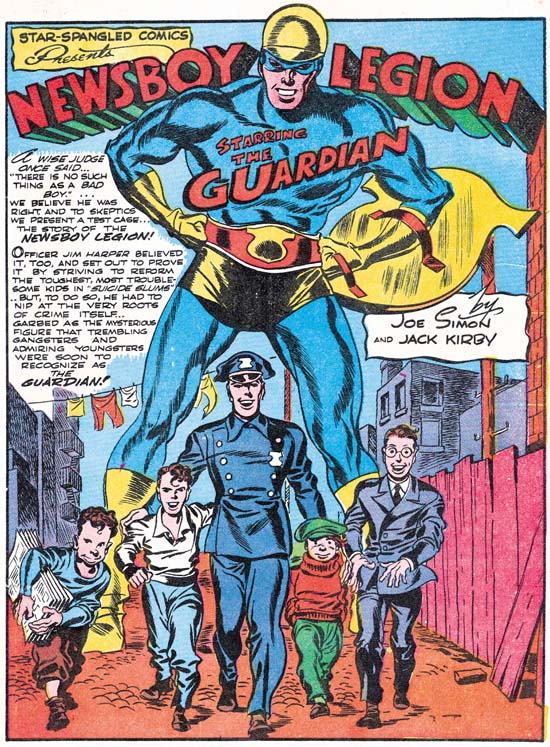
Star Spangled #7 (April 1942) page 1, art by Jack Kirby
The inking style that Simon and Kirby adopted after leaving Timely provided much of what made Simon and Kirby art look so unique. I used to I refer to this as their DC style but I fear that might give the impression that Simon and Kirby were adopting DC’s manner of inking and nothing could be further from the truth. So I think I will call it S&K’s Sculptural style since their use of form lines to create negative highlights for suggesting shape is a technique many sculptors have used when drawing. (See my Inking Glossary for explanations for explanations for some of the terms I will use in this post.) Aspects of this style can be seen in parts of Simon and Kirby’s Timely work. Perhaps the use of a number of assistants for the inking prevented the Timely art from more uniformly presenting this style. In any case starting with their work for DC and the covers they were also doing at this time for Al Harvey, Simon and Kirby inking would have two prominent characteristics; Caniff style cloth folds and bold form lines. Neither of these inking techniques was unique to Simon and Kirby but the boldness of the brush strokes were. The splash for the untitled origin story of the Newsboy Legion shown above is a good example of the early use of the Sculptural style. Take particular notice of the simple oval cloth folds that can be found in this splash particularly on Tommy’s lower legs. Not only are they simple in shape but they seem very flat without bending with the underlying shape. This type of clothing folds can be found not only in Sculptural style inking, but with the post-war Studio style as well and finally forming an important characteristic of Kirby’s Severe style of inking. I think this is an indication that Jack did at least some of the spotting for the origin story splash. Also note the course crosshatching on the buildings in the background. DC management would derogatorily designate this as “hay” and S&K’s use of this inking method would be the recurring cause of friction.
The Sculptural style can be distinguished from the Studio style by its greater dependence on form lines but also by the general lack of some of the latter’s typical inking methods such as picket fence crosshatching, drop strings, shoulder blots, and abstract arch shadows. However predecessors for some of the Studio style inking techniques may be found in the Sculptural style. In the origin splash Jim Harper’s shoulders have what almost look like shoulder blots although narrower in shape then the true shoulder blots of the Studio style. Big Word’s shoulders show that these proto-shoulder blots are actually overlapping form lines differing only in location from the form lines found throughout the splash.
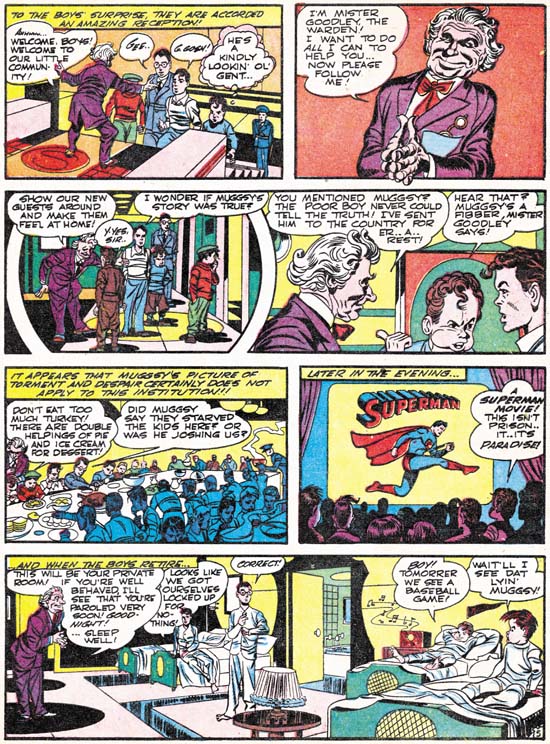
Star Spangled #11 (August 1942) “Paradise Prison” page 5, art by Jack Kirby
The second panel of page 8 of “paradise Prison” provides another example of a proto-shoulder blot. Once again the shoulders have narrow blots. the shoulder inking does give an appearance of being made from overlapping form lines although not as distinctly the case as those for example on the villain’s arm. Note the unusual appearance of Superman as presented as part of a movie. It marks one of the few Simon and Kirby nods of recognition to their publisher’s flagship character. I cannot help but wonder if Superman’s awkward pose was deliberate.

Star Spangled #8 (May 1942) “Last Mile Alley” page 10, art by Jack Kirby
Picket fence crosshatching is another inking method typical of the Studio style. Yet again examples that could be described as proto-picket fence show up in the inking of DC stories. The Guardian’s back in panel 5 of “Last Mile Alley” shown above is a case in point. The rails however are used to clearly indicate the form which is not typically the case with true picket fence brush work. Also part of the proto-picket fence is not delimited by a rail but a series of form lines instead. Not only is the proto-picket fence distinguishable in manner from the Studio style technique it is also only very infrequently used in the Sculptural style of inking.

Star Spangled #7 (April 1942) <untitled> page 5, art by Jack Kirby
Another staple of the Studio style is the abstract arch shadow. I normally use the term abstract arch shadow to describe cases where a shadow was delimited on both sides with an arc. However Simon and Kirby also frequently used shadows with only one arc. The use of single arc shadows inking appears in the DC style as well as can be seen in panels 1 and 3 from the fifth page of the origin story shown above. Such shadows can be termed abstract as well because there often is no clear explanation for their shape. Unexplained shadows were used by Simon and Kirby as a design tool to make a scene more visually interesting. Note the decided abstract shadows, without any arcs, in the sixth panel. That abstract shadows are more frequently arced was due to S&K’s use of oval and semi-circular forms as a compositional device. Such touches might be easily overlooked but they are important part of Simon and Kirby’s successful imagery.

Star Spangled #11 (August 1942) “Paradise Prison” page 8, art by Jack Kirby
I do not want to leave the reader with the idea that during S&K’s tenure at DC all manifestations of otherwise Studio inking methods were done in atypical manners. That may be true of shoulder blots and picket fence crosshatching but it is certainly not true of abstract arch shadows. The arch shadow in the last panel of page 8 of “Paradise Prison” is perfectly indistinguishable from abstract arches that appeared after the war. While the manner of execution of abstract arches may be the same between the two periods their frequency is not. Abstract arch shadows show up often in Studio style art but are rare with DC style inking. The example I provided above was the earliest that I spotted among the Newsboy Legion art.
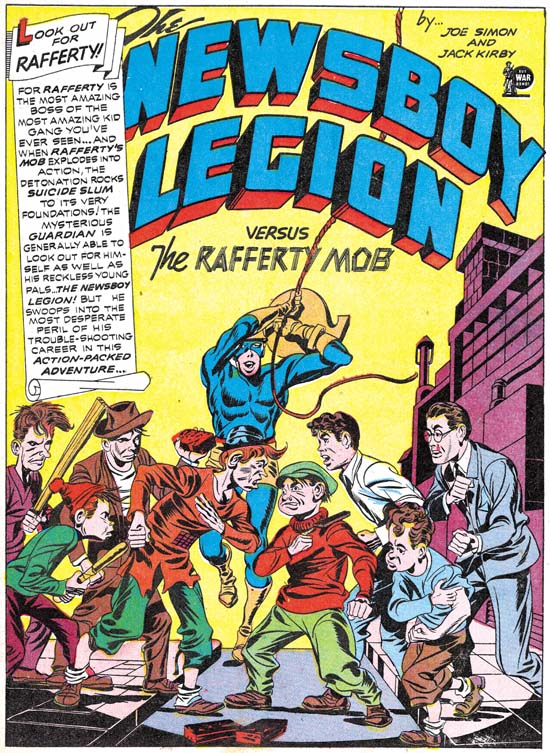
Star Spangled #17 (February 1943) “The Rafferty Mob” page 1, art by Jack Kirby
I use the term Sculptural inking style for much of the inking done by Simon and Kirby during the war but it was by no means a static approach to inking. That should not be surprising because Simon and Kirby’s art was always evolving. The form lines found in the splash from Star Spangled #7 (April 1942, shown earlier in the post) would become bolder over time as exemplified by the splash from Star Spangled #17 (February 1943). I am not convinced that “The Rafferty Mob” splash was inked by Kirby but the inking still matches the Sculptural style.

Star Spangled #12 (July 1942) “Prevue of Peril” page 1, art by Jack Kirby
I wanted to close this post on the earlier Newsboy Legion art with a splash selected solely because it is so neat. Simon and Kirby occasionally include recognizable people in their comics. In this case the Hollywood personalities played no part in the story that followed but who cares? Starting from the top and going clockwise we find Carmen Miranda, Bing Crosby, Bob Hope, an unidentified actress, Errol Flynn, Hedy Lamarr (fortunately Scrapper calls out her name or I probably would not have identified her), Mickey Rooney, and Clark Gable. I sometimes wonder if that unidentified red head might be Lucille Ball but would all the B movies she was in before her television success make her a recognizable figure at that time?


